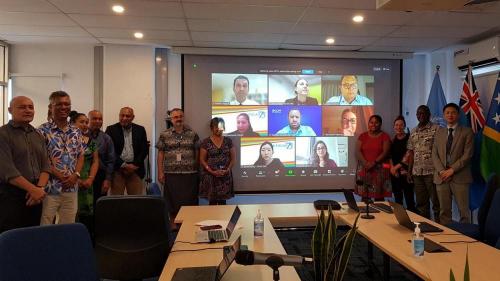
https://www.unescap.org/news/new-report-highlights-increased-disaster-ri...
The report, which builds on the latest scientific evidence by the Intergovernmental Panel on Climate Change, was launched yesterday at an event hosted by the United Nations Economic and Social Commission for Asia and the Pacific (ESCAP), the United Nations Disaster Risk Reduction (UNDRR) Pacific Subregional Office and the UN Resident Coordinator Office (UNRCO).
This report is among the first to present resilience-based analytics and recommendations to operationalize the strategic pathways on climate change and disasters outlined in the 2050 Strategy for the Blue Pacific Continent adopted in July 2022.
The launch event also served as a platform to better understand the needs of integrating climate change adaptation and resilience into development plans, share experiences on promoting climate change adaptation strategies, and discuss ways to strengthen regional and subregional cooperation to address climate change challenges.
At the opening, UNRC ai and UNDP Pacific Representative Levan Bouadze, remarked, “Tailored resilience-based, sub-regional analysis, like our Asia Pacific Disaster Report 2022: Pathways for Adaptation and Resilience in the Pacific that is being launched today, is exactly what the UN should be developing for Pacific Island countries.”
“Innovative tools and technologies are the critical means, from next generation risk analytics to geo-spatial modeling and the use of artificial intelligence and machine learning,” said Deputy Executive Secretary of ESCAP Kaveh Zahedi. He further highlighted the Asia-Pacific Risk and Resilience Portal, launched by ESCAP last year, as a user-friendly one stop shop for policymakers to access a vast array of scientific data and information and tools to make risk informed policy decisions.
Acting Secretary General of the Pacific Islands Forum Secretariat (PIFS) Dr. Filimon Manoni highlighted, “Focusing on some key adaptation priorities can help build resilience in the Pacific. These include strengthening early warning systems, making water resources more resilient, making new infrastructure resilient, protecting mangroves and improving dryland agriculture crop production. These five measures will provide the highest cost-benefit ratio in terms of building resilience to tropical cyclones and other hazards.”
The event also raised the importance of an inclusive and multidimensional approach to translate transboundary hazards into risk-informed recommendations for resilience building efforts in the Pacific. The outcome of the event will provide substantive insight and key takeaways to the upcoming high-level meetings, namely the Inaugural Meeting of Pacific Ministerial responsible for Disaster Risk Management on 14-15 September 2022 in Nadi, Fiji, the Asia-Pacific Ministerial Conference on Disaster Risk Reduction on 19-22 September 2022 in Brisbane, Australia, and COP 27 in November 2022 in Sharm El-Sheikh, Egypt.
The event was attended by member States, PIFS, Secretariat of the Pacific Regional Environment Programme (SPREP) and Council of Regional Organizations in the Pacific (CROP) agencies, as well as UN system and other key stakeholders from the Pacific.
For more information: https://www.unescap.org/Launch-Asia-Pacific-Disaster-Report-2022-for-ESCAP-Sub-regions










Add new comment